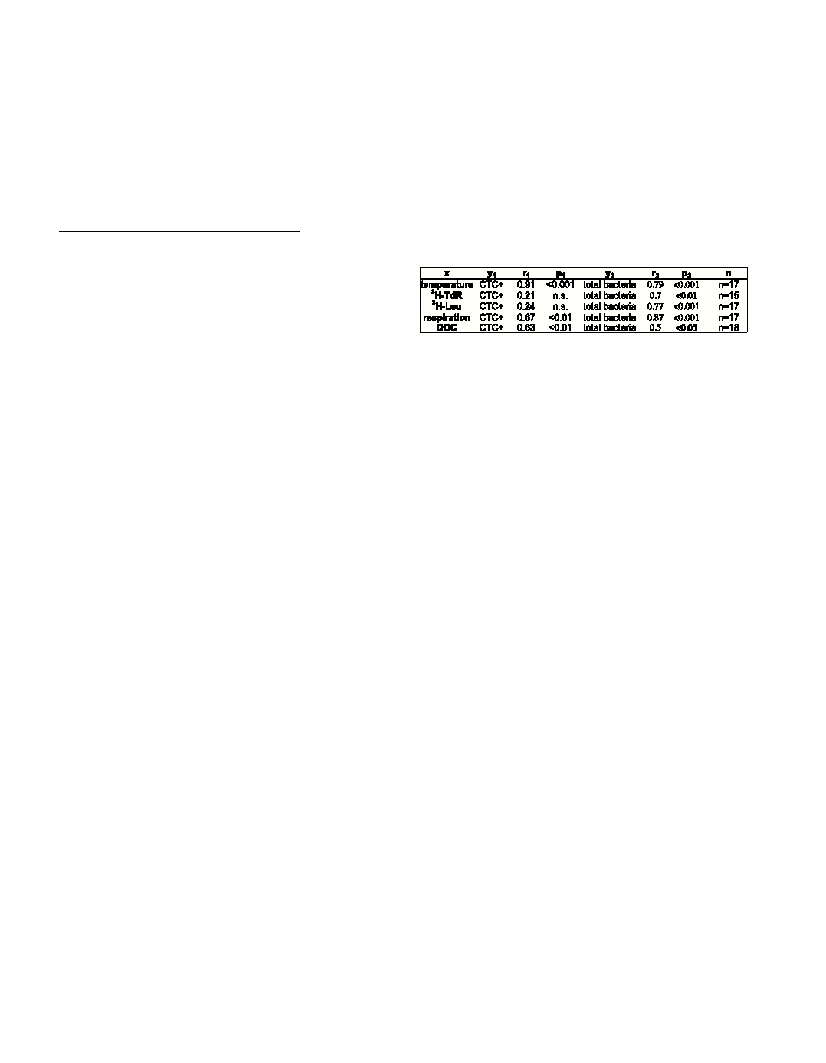Rapp. Comm. int. Mer Médit., 37,2004
277
HIGHLY ACTIVE BACTERIA IN THE SURFACE WATERS
OF THE GULF OF TRIESTE (NORTHERN ADRIATIC SEA)
A. Karuza*, P. Del Negro, A. Paoli, S. Comisso, S. Fonda Umani
Laboratory of Marine Biology, Via Auguste Piccard 54, 34010 Trieste, Italy
Abstract
In this study we examined the metabolically active fraction of bacterial community in surface waters of the Gulf of Trieste using the CTC
incubation method technique. The results suggested that the CTC+ cells are not responsible for the bulk of bacterial activity. The method
seems to be adequate to detect only the cells with very active metabolism but not the cells in a transitory metabolic state. Therefore the
CTC reduction assay should be viewed and interpreted as an efficient method for identifying the most highly active cells in
bacterioplankton populations or assemblages.
Keywords: CTC, active bacteria, Gulf of Trieste
In the bulk of bacterial community there are at least three categories
of cells that should be of biogeochemical relevance: i) actively
growing cells which contribute to production and biomass ii) living
but inactive cells and iii) dead and inactive cells. Although
discrimination among these three cellular categories remains unclear
(1), some methods have been suggested to determine the fraction of
actively growing cells in complex assemblages.
For the purpose of our study we choose the CTC incubation
method, a simple and fast technique to determine the number of
bacteria that have measurable rates of electron transport system and
therefore an active respiration.
Surface (0.5 m) water samples were bimonthly collected in a
coastal station of the Gulf of Trieste from June 2002 to April 2003.
Total bacteria abundances were determined using DAPI staining
method (2), while metabolically active cells were detected using a
CTC incubation technique (3). Bacterial Carbon Production (BCP)
was determined by
3
H-leucine and
3
H-thymidine incorporation (4).
Dissolved Organic Carbon (DOC) concentration was assessed by high
temperature catalytic oxidation (5). Rates of oxygen utilization were
calculated from changes in dissolved oxygen concentration, using the
Winkler method, over a 24 h period in samples incubated in the dark
and in situtemperature. Temperature data were obtained by a Idronaut
Ocean Seven (Model 316) multiparametric probe.
Bacterial abundances ranged between 2.51 x 10
8
and 4.78 x 10
9
cells L
-1
whereas the number of active cells (CTC+) ?uctuated from
1.72 x 10
6
to 9.92 x 10
7
cells L
-1
. The percentage of CTC+ bacteria
ranged between 0.03 and 7.41%. The abundance of CTC+ cells was
strongly correlated to total bacterial numbers and, better than with
total bacteria, it showed strict relationships with temperature and
substrate availability, evaluated as DOC concentration. On the
contrary, bacterial production, measured as
3
H-leucine and
3
H-
thymidine incorporation, were correlated to total number of bacteria
only (Tab.1). Respiration rate within the plankton community
resulted strongly correlated to total number of bacteria where the
active fraction only partially support the respiration process.
Setting aside methodological differences, our results, like those of
many other authors (e.g. 6), show that not all bacteria are
metabolically active and that the water temperature appears to have
had a profound effect on the pattern of induction of respiration
activity. The statistical dependence between CTC+ bacteria and DOC,
could have been caused solely by the increase in temperature which is
also usually the controlling factor in the phenomena involved in the
production of autochthonous organic matter readily assimilable by
bacteria.
Although it could seem surprisingly because of the principle of the
CTC method based on detecting cell respiratory activity characteristic
for growing cells, oxygen consume rate and BCP had better statistical
relationships with total bacteria abundances rather than active cells,
contrarily to the results of Smith (7). This could concern a limit of the
method that detects only the cells with very active metabolism but not
the cells in a transitory state, between CTC+ and CTC-, that
contribute to the total respiration measured and therefore the CTC
reduction assay should be viewed and interpreted as identifying the
most highly active cells in bacterioplankton populations or
assemblages. Indeed, the level of cell activity is what determines the
detectability of respiring cells, since even bacteria in a starvation
survival state must sustain certain functions.
Table 1. Parameters of linear regression analysis.
References
1-Gasol J.M., Zweifel U.L., Peters F., Fuhrman J.A. and Hagstrom A.,
1999. Significance of size and nucleic acid content heterogeneity as
measured by ?ow citometry in natural plankton bacteria. Appl. Environ.
Microbiol.,65: 4475-4483.
2-Porter K.G. and Feig Y.S., 1980. The use of DAPI for identifying and
counting aquatic micro?ora. Limnol. Oceanogr.,25: 943-948.
3-Rodriguez G.G., Phipps D., Ishiguro K. and Ridgeway H.F., 1992. Use
of a ?uorescent redox probe for direct visualization of actively respiring
bacteria. Appl. Environ. Microbiol., 58: 1801-1808.
4-Smith D.C. and Azam F., 1992. A simple, economical method for
measuring bacterial protein synthesis rates in sea water using 3H-leucine.
Mar. Microb. Food Webs, 6: 107-114.
5-Sugimura Y. and Suzuki Y., 1988. A high-temperature catalytic
oxidation method for the determination of non-volatile dissolved organic
carbon in seawater by direct injection of a liquid sample. Mar. Chem.,24:
105-131.
6-Jugnia L.B., Debroas R.D., Sime-Ngando T. and Devaux J., 2000.
Variations in the number of active bacteria in the euphotic zone of a
recently ?ooded reservoir. Aquat. Microb. Ecol.,22: 251-259.
7-Smith E.M., 1998. Coherence of microbial respiration rate and cell-
specific bacterial activity in a coastal planktonic community. Aquat.
Microb. Ecol., 16: 27-35.

